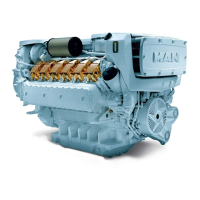
Do you have a question about the Man V8-1000 and is the answer not in the manual?
Provides information on the provisional nature and scope of the operating instructions.
Explains the meaning of signal words, warnings, notes, and general instruction symbols.
Emphasizes using genuine MAN spare parts and accessories for reliability and safety.
Provides guidance on the environmentally responsible disposal of engine components.
Outlines conditions that may lead to loss of warranty claims, including instruction adherence.
Information on obtaining technical support and assistance from MAN customer service.
Defines the engine's purpose and states MAN's non-liability for damage from non-intended use.
Details the operator's duties regarding work safety, compliance with regulations, and personnel management.
Specifies qualifications for personnel handling the engine and requirements for authorized persons.
Lists essential personal protective equipment (PPE) for minimizing health risks during work.
Identifies residual risks related to electrical current, moving parts, exhaust gases, and flammable substances.
Mandates the presence and proper function of safety equipment like emergency stop devices.
Stresses the need for suitable protective equipment, beyond the standard V-belt cover.
Provides guidance on preventive measures and actions to take during emergencies or accidents.
Explains important safety signs and their meanings to ensure awareness of hazards.
Details precautions for handling fuels, lubricants, and coolants to prevent environmental pollution.
Explains the components and identifiers found on the engine's identification number plate.
Provides a breakdown of the engine's model designation codes and their meanings.
Instructs users to check and record engine model plate data for correspondence and inquiries.
Addresses the requirement for an emission control label and duplicate placement if needed.
Describes the typical applications and approved modes of operation for the marine engines.
Details the engine's construction, including cylinder count, bore, stroke, and key systems.
Provides visual identification of engine components through front left and rear right views.
Outlines essential preparation steps and personal protective equipment before handling.
Covers critical safety warnings related to lifting, handling packages, and unauthorized transport.
Instructs on checking deliveries for missing items or transport damage and initiating claims.
Details procedures for lifting and transporting the engine, with and without a gearbox.
Explains the purpose of packaging and how to handle packing materials responsibly.
Specifies ideal conditions for storing engine packages to maintain their integrity.
Provides general guidance and safety instructions for installing and commissioning the engine.
Describes the engine installation process, focusing on interfaces between the engine and the plant.
Covers final assembly steps, including E-box accessibility and checking crankshaft axial clearance.
Details the process of installing engine and gearbox mounts as part of the propulsion system.
Explains how to connect sea water lines for engine cooling and the gearbox oil cooler.
Provides instructions for connecting the fuel feed and return lines to the engine.
Describes the exhaust gas outlet on the engine and connecting the exhaust system.
Lists specified tightening torques for various threaded connections according to Works Standard M 3059.
Details the critical steps and requirements for initial engine commissioning to ensure operational safety.
Stipulates the necessity of wearing personal protective equipment before operation.
Outlines ground rules for safe engine operation, emphasizing personnel qualifications and work area tidiness.
Covers essential daily inspections and checks of fuel, coolant, and oil levels before operation.
Explains the correct procedures for starting and stopping the engine using ignition lock or buttons.
Describes operating ranges for marine engines and the use of display systems and instruments.
Specifies personal protective equipment and general safety precautions for maintenance.
Highlights safety measures for personnel performing maintenance, including engine shutdown.
Refers to available maintenance schedules for routine engine upkeep.
Covers specific maintenance tasks such as engine oil change, fuel filter maintenance, and coolant changes.
Describes how fault and alarm information is displayed on the MMDS CLC 6.5 control unit.
Explains the function of the E-box display for visual indication of engine alarms in the engine room.
Outlines necessary PPE and ground rules for engine decommissioning and recommissioning.
Emphasizes the need for trained personnel and safe working practices during these procedures.
Provides precautions for temporary engine shutdown to prevent corrosion and ensure readiness.
Details the procedures for safely restarting engines after periods of shutdown or storage.
Lists the dry weights and key dimensions (A, B, C) for different engine models.
Refers to installation instructions for information on assembly location and necessary space.
Provides detailed specifications for various engine models, including bore, stroke, rating, and torque.
Lists common abbreviations used throughout the manual with their full meanings.
Provides definitions for technical terms and acronyms relevant to the engine and its systems.